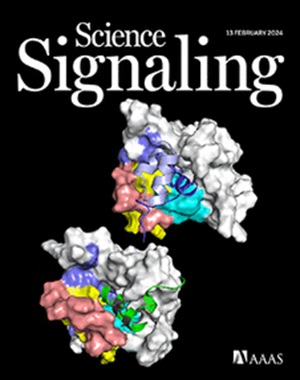The E3 ubiquitin ligase ZNRF3 restricts WNT receptor complex activity by stimulating the selective degradation of WNT-engaged FZD
IF 6.6
1区 生物学
Q1 BIOCHEMISTRY & MOLECULAR BIOLOGY
引用次数: 0
Abstract
Ligands of the WNT family induce formation of the WNT receptor signalosome and promote stabilization of the transcriptional coactivator β-catenin. The homologous transmembrane E3 ubiquitin ligases ZNRF3 and RNF43 inhibit WNT-dependent stabilization of β-catenin by stimulating the degradation of the WNT receptor FZD, whereas the secreted R-spondin proteins promote the stabilization of FZD by inducing the degradation of ZNRF3 and RNF43. Here, we report that the R-spondin–induced stabilization of β-catenin in HEK293 cells was not mimicked by FZD overexpression, highlighting a gap in our understanding of this important regulatory mechanism. Contrary to the conventional view that ZNRF3 constitutively mediates the ubiquitylation and degradation of FZD, we found that ZNRF3-induced FZD degradation depended on endogenous WNT and that ZNRF3 selectively degraded WNT-engaged FZD. WNT enhanced the association between FZD and the intracellular adaptor protein DVL, and DVL subsequently recruited ZNRF3 to FZD to promote FZD degradation. Our data suggest that WNT signaling actively restricts itself through ZNRF3-dependent degradation of WNT-engaged FZD and that R-spondin enhances WNT signaling by prolonging the action of the WNT-engaged FZD complex, rather than by simply increasing the abundance of FZD on the cell surface.
E3泛素连接酶ZNRF3通过刺激WNT参与的FZD的选择性降解来限制WNT受体复合物的活性
WNT家族的配体诱导WNT受体信号体的形成,并促进转录辅激活因子β-连环蛋白的稳定。同源的跨膜E3泛素连接酶ZNRF3和RNF43通过刺激WNT受体FZD的降解来抑制WNT依赖性β-catenin的稳定,而分泌的R-spondin蛋白通过诱导ZNRF3和RNF43的降解来促进FZD的稳定。在这里,我们报道了r -spondin诱导的HEK293细胞中β-catenin的稳定并没有被FZD过表达所模仿,这突出了我们对这一重要调节机制的理解上的差距。与ZNRF3组成型介导FZD泛素化和降解的传统观点相反,我们发现ZNRF3诱导的FZD降解依赖于内源性WNT,并且ZNRF3选择性地降解WNT参与的FZD。WNT增强了FZD与细胞内接头蛋白DVL之间的联系,DVL随后将ZNRF3募集到FZD中,促进FZD的降解。我们的数据表明,WNT信号通过依赖于znrf3的WNT-接合FZD的降解来主动限制自身,R-spondin通过延长WNT-接合FZD复合物的作用来增强WNT信号,而不是简单地增加细胞表面FZD的丰度。
本文章由计算机程序翻译,如有差异,请以英文原文为准。
求助全文
约1分钟内获得全文
求助全文
来源期刊

Science Signaling
BIOCHEMISTRY & MOLECULAR BIOLOGY-CELL BIOLOGY
CiteScore
9.50
自引率
0.00%
发文量
148
审稿时长
3-8 weeks
期刊介绍:
"Science Signaling" is a reputable, peer-reviewed journal dedicated to the exploration of cell communication mechanisms, offering a comprehensive view of the intricate processes that govern cellular regulation. This journal, published weekly online by the American Association for the Advancement of Science (AAAS), is a go-to resource for the latest research in cell signaling and its various facets.
The journal's scope encompasses a broad range of topics, including the study of signaling networks, synthetic biology, systems biology, and the application of these findings in drug discovery. It also delves into the computational and modeling aspects of regulatory pathways, providing insights into how cells communicate and respond to their environment.
In addition to publishing full-length articles that report on groundbreaking research, "Science Signaling" also features reviews that synthesize current knowledge in the field, focus articles that highlight specific areas of interest, and editor-written highlights that draw attention to particularly significant studies. This mix of content ensures that the journal serves as a valuable resource for both researchers and professionals looking to stay abreast of the latest advancements in cell communication science.
 求助内容:
求助内容: 应助结果提醒方式:
应助结果提醒方式:


